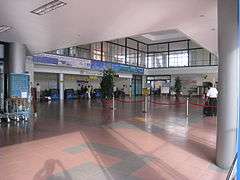Qui Nhơn
Qui Nhơn, also Quy Nhơn (Vietnamese: [kwi ɲəːŋ] (![]()
Quy Nhơn Thành phố Quy Nhơn | |
|---|---|
| Quy Nhơn City | |
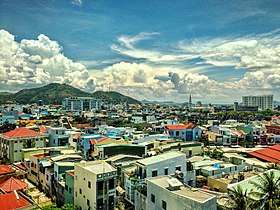 Quy Nhơn | |
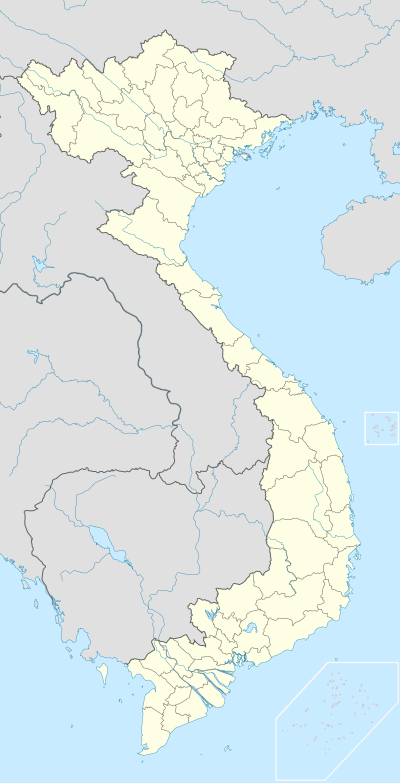 Quy Nhơn Location of in Vietnam | |
| Coordinates: 13°46′N 109°14′E | |
| Country | |
| Province | Bình Định |
| Established city | 1986 |
| Area | |
| • Total | 284 km2 (110 sq mi) |
| Population (2019) | |
| • Total | 457,400[1] |
| Time zone | UTC+7 (Indochina Time) |
| Climate | Aw |
History
The town of Quy Nhơn was officially founded in the late 18th century, although its origins stretch back much further to the 11th-century Champa culture, the Tây Sơn dynasty and the 18th century seaport of Thị Nại. During the 1620s the town was host to Portuguese Jesuits who called the place Pulo Cambi.
During the Ming treasure voyages of the 15th century, the Chinese fleet led by Admiral Zheng He would always make port at Qui Nhơn in Champa as their first destination after leaving China.[2]
The city is renowned as the birthplace of 18th century Vietnamese emperor Nguyễn Huệ[3] and, more recently, had a large American military presence during the Vietnam War. Today the city is recognized as a first class city with a geo-economic priority and an urbanized infrastructure. The government describes it as one of the three commercial and tourism centres of the central southern coastal region (with Đà Nẵng and Nha Trang).
Geography
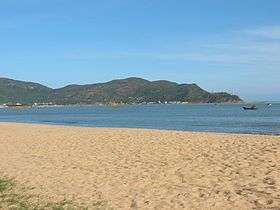
Quy Nhơn has a varied topography, being extremely diversified with mountains and forests, hills, fields, salt marshes, plains, lagoons, lakes, rivers, shorelines, peninsulas and islands. Its coastline is 42 km long with sandy beaches, abundant seafood resources and other natural products of economic value.
The city has sixteen wards: Trần Hưng Đạo, Lê Lợi, Lê Hồng Phong, Trần Phú, Lý Thường Kiệt, Nguyễn Văn Cừ, Đống Đa, Thị Nại, Hải Cảng, Ngô Mây, Ghềnh Ráng, Quang Trung, Nhơn Bình, Nhơn Phú, Bùi Thị Xuân and Trần Quang Diệu. It has five villages: Nhơn Lý, Nhơn Hội, Nhơn Châu, Nhơn Hải and Phước Mỹ (which was spun off from Tuy Phước District and merged into Quy Nhơn city in 2006) with a total area of 284.28 km² and a population of about 284,000 people.
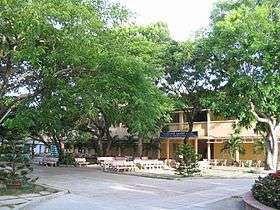
Transportation
Quy Nhơn is served by Vietnam Airlines, Bamboo Airways, VietJet Air and Pacific Airlines through Phù Cát Airport, with flights to Hanoi and Ho Chi Minh City.[4]
Quy Nhơn railway station could be reached by a branch off the main line of the North–South railway,[5] but this line was suspended in May 2016. Reunification express trains stop only in Diêu Trì railway station, which is around 10 km west of Quy Nhơn.
Economy
Quy Nhơn is one of the main industrial centres of the South Central Coast, behind only Đà Nẵng and Nha Trang.[6] It is also the major industrial and service centre of Bình Định Province, including its largest industrial facilities at Phu Tai Industrial Park and Nhơn Hội Economic Zone. The city's economic activities include industries, export-imports, seaport services, aquatic product husbandry and tourism. The economic trend, at present, is increasingly service-based at the expense of agriculture, forestry and pisciculture.
Cereals are cultivated on 2548 ha of Quy Nhơn's land with an output of 13,021 tons as of 2009, just 2% of the province's total.[7] Other crops included 10,891 tons of vegetables, 2,795 tons of sugar-cane, as well as smaller amounts of coconuts, peanuts and cashew nuts.[7]
Much of the city's industry is concentrated in and around Phu Tai Industrial Park in the west of the city along National Route 1A. Quy Nhơn is a major centre of garden furniture manufacturing. It has traditionally been relying on access to wood from Bình Định's forests as well as the Central Highlands provinces of Gia Lai and Kon Tum and even as far as Cambodia's Ratanakiri and Laos' Attapeu Province. Most of the furniture factories are located in Phu Tai Industrial Park. Several chemical enterprises that supply the furniture and wood processing industry have been set up in the vicinity of the industrial park.[8]
Other industries in Quy Nhơn process agricultural and aquatic products, or produce construction materials and paper products.[6] Bidiphar is a pharmaceutical company headquartered in Quy Nhơn that is an exception to the city's general focus on basic and wood processing industries. Nhơn Hội Economic Zone is central to the city's and province's industrial development plans. However, as of late 2010 it was still in the early stages of development, with few factories completed.
Quy Nhơn has seen only limited foreign investment. As of 2008, 13 foreign companies employed 1119 people in the city.[7]
Currently the economic structure of Quy Nhơn is a shift towards increasing the proportion of service industries, reducing the rate of agriculture, forestry and fisheries in GDP. The shares of agriculture, forestry and fisheries – industrial and construction – services in GDP in 2006 reached 36.7%, 28% and 35.3%, respectively, while in 2005 it was at 38.4%, 26.7% and 34.9%, respectively.
The income per capita in 2018 was US$6,025 per person.
Climate
Qui Nhơn has a tropical savanna climate (Köppen climate classification: As).[9][10]
| Climate data for Quy Nhơn | |||||||||||||
|---|---|---|---|---|---|---|---|---|---|---|---|---|---|
| Month | Jan | Feb | Mar | Apr | May | Jun | Jul | Aug | Sep | Oct | Nov | Dec | Year |
| Record high °C (°F) | 34.6 (94.3) |
37.9 (100.2) |
39.8 (103.6) |
42.1 (107.8) |
41.7 (107.1) |
41.4 (106.5) |
39.7 (103.5) |
39.4 (102.9) |
38.9 (102.0) |
34.7 (94.5) |
34.6 (94.3) |
33.0 (91.4) |
42.1 (107.8) |
| Average high °C (°F) | 26.9 (80.4) |
28.2 (82.8) |
29.9 (85.8) |
31.8 (89.2) |
33.8 (92.8) |
34.4 (93.9) |
34.6 (94.3) |
34.8 (94.6) |
33.0 (91.4) |
30.4 (86.7) |
28.1 (82.6) |
26.5 (79.7) |
31.0 (87.8) |
| Daily mean °C (°F) | 23.2 (73.8) |
24.0 (75.2) |
25.5 (77.9) |
27.5 (81.5) |
29.1 (84.4) |
29.8 (85.6) |
29.9 (85.8) |
29.9 (85.8) |
28.5 (83.3) |
26.8 (80.2) |
25.4 (77.7) |
23.8 (74.8) |
27.0 (80.6) |
| Average low °C (°F) | 21.1 (70.0) |
21.6 (70.9) |
23.0 (73.4) |
24.9 (76.8) |
26.2 (79.2) |
26.8 (80.2) |
26.8 (80.2) |
26.9 (80.4) |
25.6 (78.1) |
24.5 (76.1) |
23.4 (74.1) |
21.8 (71.2) |
24.4 (75.9) |
| Record low °C (°F) | 15.2 (59.4) |
15.7 (60.3) |
15.8 (60.4) |
19.4 (66.9) |
19.1 (66.4) |
21.7 (71.1) |
20.6 (69.1) |
20.7 (69.3) |
20.5 (68.9) |
17.9 (64.2) |
15.0 (59.0) |
15.5 (59.9) |
15.0 (59.0) |
| Average precipitation mm (inches) | 64 (2.5) |
28 (1.1) |
24 (0.9) |
31 (1.2) |
84 (3.3) |
64 (2.5) |
38 (1.5) |
62 (2.4) |
227 (8.9) |
549 (21.6) |
437 (17.2) |
199 (7.8) |
1,807 (71.1) |
| Average precipitation days | 13.0 | 6.0 | 4.3 | 4.1 | 8.7 | 7.5 | 7.2 | 8.6 | 16.0 | 20.7 | 21.2 | 19.1 | 136.4 |
| Average relative humidity (%) | 80.9 | 81.9 | 82.7 | 82.6 | 79.7 | 74.2 | 71.4 | 70.4 | 77.9 | 83.4 | 83.6 | 82.6 | 79.3 |
| Mean monthly sunshine hours | 162 | 194 | 251 | 262 | 270 | 243 | 254 | 234 | 193 | 169 | 123 | 115 | 2,470 |
| Source: Vietnam Institute for Building Science and Technology[11] | |||||||||||||
Education
Quy Nhơn has two universities: Quy Nhơn University and Quang Trung University. As of 2009 they had a total teaching staff of 601 and 23,383 students, 13,704 of whom were female.[7] There were 19,900 primary school students and 28,500 secondary school students.[7]
Cuisine
Quy Nhơn is home to multiple Vietnamese domestically famous dishes:
- Bánh xèo tôm nhảy (jumping-shrimps fried pancake): These pancakes are made with special formulas and each restaurant has its own way of making distinguished dipping fish sauce for this dish.
- Bánh hỏi cháo lòng: The dish composes of two sub-dishes: "Bánh hỏi" (a type of rice cake in Vietnam) and "cháo lòng" (pig's internal organs porridge).
- Bún chả cá (fish-cake rice vermicelli).
- Chả ram tôm đất (shrimp spring roll).
Notable people
- Xavier Le Pichon (1937–), French geophysicist
Gallery
 Paranomic view of Qui Nhơn city.
Paranomic view of Qui Nhơn city.- Trần Hưng Đạo monument in Hải Minh, Qui Nhơn.
 High school in Qui Nhơn.
High school in Qui Nhơn.- Qui Nhơn train station.
- Qui Nhơn beach.
- A port in Qui Nhơn.
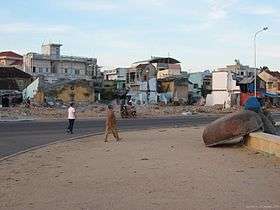 Qui Nhơn.
Qui Nhơn. Qui Nhơn beach.
Qui Nhơn beach.
Notes
References
- "Tổng điều tra dân số và nhà ở Việt Nam năm 2009: Kết quả toàn bộ". Ban chỉ đạo Tổng điều tra dân số và nhà ở trung ương. p. 23.
- Dreyer, Edward L. (2007). Zheng He: China and the Oceans in the Early Ming Dynasty, 1405–1433. New York: Pearson Longman. p. 52. ISBN 9780321084439.
- Discover Vietnam Archived April 9, 2010, at the Wayback Machine
- "Domestic flights in Vietnam". Indochina Travel Service (in Vietnamese and English). Dong Duong Co. 2012. Retrieved 15 October 2012.
- https://web.archive.org/web/20100418132723/http://www.vr.com.vn/English/hientaihoatdong.html. Archived from the original on April 18, 2010. Retrieved November 21, 2009. Missing or empty
|title=(help) - Atlat Dia li Viet Nam (Geographical Atlas of Vietnam). NXB Giao Duc, Hanoi: 2010
- Bình Định Statistics Office (2010): Bình Định Statistical Yearbook 2009. Statistical Publishing House, Hanoi
- People's Committee Bình Định (2007): Yearbook of Information on Enterprises in Bình Định Province. Labour Publishing House, Hanoi: 162–165
- Kottek, Markus; Grieser, Jürgen; Beck, Christoph; Rudolf, Bruno; Rubel, Franz (2006). "World Map of the Köppen-Geiger climate classification updated" (PDF). Meteorologische Zeitschrift. 15 (3): 259–263. Bibcode:2006MetZe..15..259K. doi:10.1127/0941-2948/2006/0130.
- Peel, M. C.; Finlayson B. L. & McMahon, T. A. (2007). "Updated world map of the Köppen–Geiger climate classification" (PDF). Hydrol. Earth Syst. Sci. 11 (5): 1633–1644. doi:10.5194/hess-11-1633-2007. ISSN 1027-5606.
- "Vietnam Building Code Natural Physical & Climatic Data for Construction" (PDF). Vietnam Institute for Building Science and Technology. Archived from the original (PDF) on 22 July 2018. Retrieved 20 July 2018.
External links
| Wikimedia Commons has media related to Quy Nhon. |

